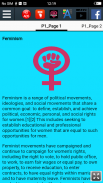








History of feminism

คำอธิบายของHistory of feminism
The history of feminism is the chronological narrative of the movements and ideologies aimed at equal rights for women. While feminists around the world have differed in causes, goals, and intentions depending on time, culture, and country, most Western feminist historians assert that all movements that work to obtain women's rights should be considered feminist movements, even when they did not (or do not) apply the term to themselves.[1][2][3][4][5] Other historians limit the term to the modern feminist movement and its progeny, and instead use the label "protofeminist" to describe earlier movements.[6]
Modern Western feminist history is split into three time periods, or "waves", each with slightly different aims based on prior progress.[7][8] First-wave feminism of the 19th and early 20th centuries focuses on overturning legal inequalities, particularly women's suffrage. Second-wave feminism (1960s–1980s) broadened debate to include cultural inequalities, gender norms, and the role of women in society. Third-wave feminism (1990s–2000s) refers to diverse strains of feminist activity, seen as both a continuation of the second wave and a response to its perceived failures.[9] Although the waves construct has been commonly used to describe the history of feminism, the concept has also been criticized for ignoring and erasing the history between the "waves", by choosing to focus solely on a few famous figures, and popular events.[10]
ประวัติความเป็นมาของสตรีคือการเล่าเรื่องตามลำดับของการเคลื่อนไหวและอุดมการณ์มุ่งเป้าไปที่สิทธิที่เท่าเทียมกันสำหรับผู้หญิง ในขณะที่สตรีทั่วโลกได้แตกต่างกันในสาเหตุที่เป้าหมายและความตั้งใจที่ขึ้นอยู่กับเวลาวัฒนธรรมและประเทศส่วนใหญ่ในประวัติศาสตร์สตรีนิยมตะวันตกยืนยันว่าการเคลื่อนไหวทั้งหมดที่ทำงานที่จะได้รับสิทธิสตรีควรได้รับการพิจารณาการเคลื่อนไหวเรียกร้องสิทธิสตรีแม้ในขณะที่พวกเขาไม่ได้ (หรือ ไม่ได้) ใช้คำว่าตัวเอง. [1] [2] [3] [4] [5] ประวัติศาสตร์อื่น ๆ จำกัด ระยะการเคลื่อนไหวเรียกร้องสิทธิสตรีที่ทันสมัยและลูกหลานของตนและใช้แทนป้าย "protofeminist" เพื่ออธิบายการเคลื่อนไหวก่อนหน้านี้. [6]
โมเดิร์นประวัติศาสตร์สตรีนิยมตะวันตกจะถูกแบ่งออกเป็นสามช่วงเวลาหรือ "คลื่น" แต่ละคนมีจุดมุ่งหมายแตกต่างกันเล็กน้อยขึ้นอยู่กับความคืบหน้าก่อน. [7] [8] สตรีคนแรกที่คลื่นของศตวรรษที่ 20 และ 19 และต้นมุ่งเน้นไปที่ความไม่เท่าเทียมกันทางกฎหมายคว่ำโดยเฉพาะอย่างยิ่งสตรีอธิษฐาน ประการที่สองคลื่นสตรี (1960- 1980) ขยายการอภิปรายที่จะรวมถึงความไม่เท่าเทียมกันทางวัฒนธรรมบรรทัดฐานทางเพศและบทบาทของผู้หญิงในสังคม สามคลื่นสตรี (1990 -2000) หมายถึงสายพันธุ์ที่มีความหลากหลายของกิจกรรมสตรีมองว่าเป็นทั้งความต่อเนื่องของคลื่นลูกที่สองและการตอบสนองต่อความล้มเหลวในการรับรู้ของมัน. [9] แม้ว่าคลื่นสร้างได้รับการนิยมใช้ในการอธิบายประวัติศาสตร์ของสตรีแนวคิดนี้ยังได้รับการวิพากษ์วิจารณ์โดยไม่สนใจและลบประวัติศาสตร์ระหว่าง "คลื่น" โดยเลือกที่จะมุ่งเน้น แต่เพียงผู้เดียวในตัวเลขที่มีชื่อเสียงน้อยและกิจกรรมที่นิยม. [10 ]
























